
YUMPU automatically turns print PDFs into web optimized ePapers that Google loves.

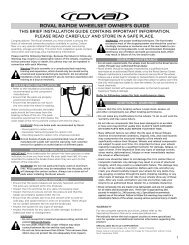
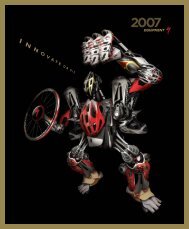
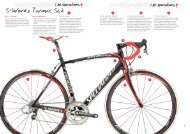
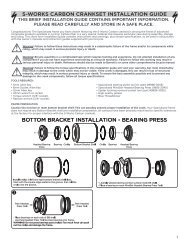
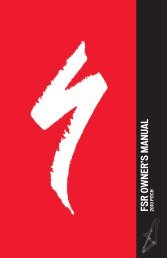
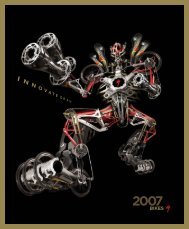
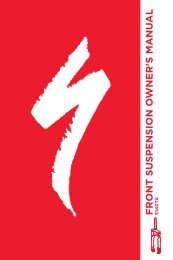
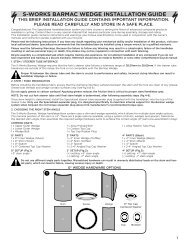
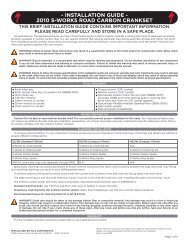 works road carbon crankset - Specialized Bicycles" width="208" height="300" />
works road carbon crankset - Specialized Bicycles" width="208" height="300" />
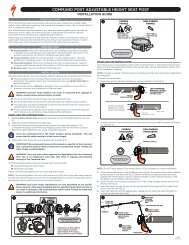
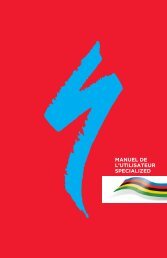
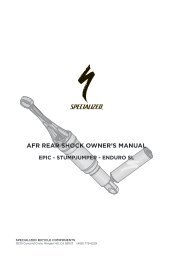

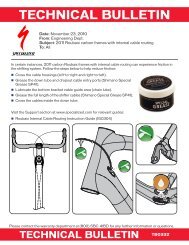
CARBON ROAD FORK INSTALLATION GUIDE WARNING! IMPORTANT NOTICE. READ CAREFULLY. Congratulations! The Specialized fork you have chosen is among the finest of advanced composite products available in cycling. Carbon fiber is a very special material that requires particular care for proper installation. Please read the following instructions. If you have any doubt regarding your mechanical ability and/or installation of this product, visit your local authorized dealer. Specialized recommends that the stem be installed on the fork using a torque wrench, by a qualified mechanic. Please read the following Warnings. Because the failure to follow any Warning may result in a catastrophic failure of the fork, resulting in serious personal injury or death, this phrase may not be repeated in connection with each Warning. PREPARING THE COMPONENTS Inspect the fork and stem to ensure that there are no burrs or sharp edges that can damage the surface in contact with each other. Remove any burrs or sharp edges using fine grit sandpaper. All edges in contact with the steerer tube should be rounded out to eliminate any stress points. 1 Warning! Burrs and sharp edges can damage the carbon and alloy surfaces of the components. Any deep scratches or gouges in the stem or fork can weaken the components. External slotted clamp Internal Wedge NOTE: Specialized recommends using an external slotted clamp style stem. Internal wedge clamp style stems can cause damage to the steerer tube if improperly installed. (fig. 1) PREPARING THE FORK Forks without an integrated crown race: Before installing the crown race at the base of the steerer tube, apply a small amount of grease to the contact surface. Using a crown race installation tool, seat the crown race onto the base of the steerer tube. Do not place the fork dropouts against any surface to brace the fork when seating the crown race. This can damage the fork dropouts. It is recommended that the fork be held by the legs when installing the crown race. All forks: Following the headset manufacturer’s instructions (for Specialized headsets, refer to the frame installation guide), insert the headset into the frame. Place the fork in the frame, followed by the desired amount of headset spacers and the stem. Do not apply any grease to the steerer tube. NOTE: Do not install more than 40mm (1.5”) stack height of headset spacers. Exceeding this limit can compromise the strength of the steerer tube. (fig.2) Unless the desired stem height is already determined, it is recommended that the initial installation of the fork be done with the maximum allowed stack height (40mm) to allow the greatest range of adjustability. Spacers can be placed above or below the stem to adjust your position. Once a more precise stem height is determined, a second cut can be made to eliminate any spacers that may have been placed above the stem to achieve the desired position. Warning! Do not permanently place stem spacers above the stem. Placing spacers above the stem defeats the purpose of the expander plug’s ability to support the steerer tube and stem. 2 3mm STEERER TUBE PLUG SPACERS BELOW STEM RIGHT 40mm max CUTTING THE FORK STEERER TUBE Forks with carbon fiber steerer tubes: Once the initial stem height is achieved, make a mark on the steerer tube at the top of the stem. The actual cutting line must be placed 3mm below the mark (to make room for the Specialized 48mm Long Expander Plug. See Fig. 2). Wrap the area where you intend to cut the fork with several layers of masking tape. This will limit the amount of fraying of the fibers, resulting in a cleaner cut. Once you’ve wrapped the layers of tape, determine the precise location of the desired cut with a pen mark on the tape. Forks with alloy steerer tubes: Cut the steerer tube 2mm below the top of the stem, since there is no need to use an expander plug. NOTE: To avoid fraying the composite fibers, Specialized recommends using a carbon-specific saw blade. A fine tooth (36 teeth) saw blade is also acceptable. Double check all measurements to make sure the steerer tube will not be cut too short. It’s easier to measure twice than to buy a new fork. NOTE: It is very important that the steerer tube is cut straight. For best results, use a steerer tube cutting guide tool. Once the steerer tube is cut to the desired length, be sure to remove all burrs at the top of the steerer tube by rounding out the edge with emery paper or a fine grit sand paper. Wipe off all excess dust. Be sure not to breathe carbon dust! For additional information on carbon fiber preparation, please visit the tech section at www.specialized.com. Warning! Carbon fiber steerer tubes require the use of the expander plug assembly supplied with the fork. Do not use a star nut, it can damage the inside surface of the steerer tube. Damage to the steerer tube can result in failure, causing serious personal injury or death. 3 Recommended Torque: 80 in-lbf (9.0 N-m) 48mm STEM SPACER PLACEMENT 28mm 23.6mm SPACERS ABOVE STEM LONG EXPANDER PLUG 48MM LONG EXPANDER WRONG